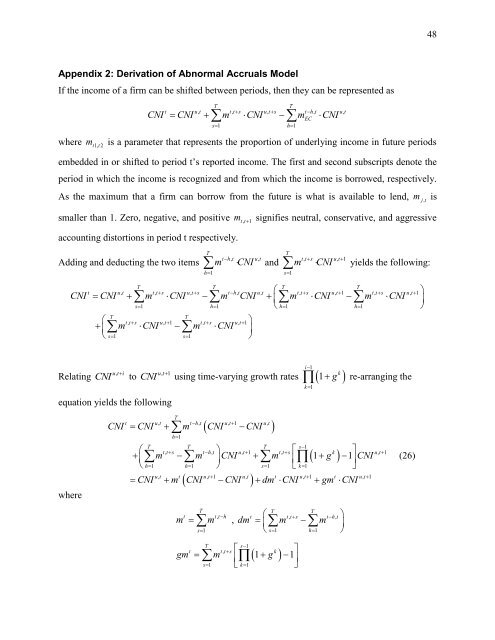Modelling the accruals process and assessing unexpected accruals*
Modelling the accruals process and assessing unexpected accruals*
Modelling the accruals process and assessing unexpected accruals*
Create successful ePaper yourself
Turn your PDF publications into a flip-book with our unique Google optimized e-Paper software.
Appendix 2: Derivation of Abnormal Accruals Model<br />
If <strong>the</strong> income of a firm can be shifted between periods, <strong>the</strong>n <strong>the</strong>y can be represented as<br />
t<br />
<br />
T<br />
u, t<br />
<br />
t, ts <br />
T<br />
u, ts th, t<br />
EC <br />
u, t<br />
s1 h1<br />
CNI CNI m CNI m CNI<br />
where m t1, t2<br />
is a parameter that represents <strong>the</strong> proportion of underlying income in future periods<br />
embedded in or shifted to period t‟s reported income. The first <strong>and</strong> second subscripts denote <strong>the</strong><br />
period in which <strong>the</strong> income is recognized <strong>and</strong> from which <strong>the</strong> income is borrowed, respectively.<br />
As <strong>the</strong> maximum that a firm can borrow from <strong>the</strong> future is what is available to lend, m jt , is<br />
smaller than 1. Zero, negative, <strong>and</strong> positive mtt , 1 signifies neutral, conservative, <strong>and</strong> aggressive<br />
accounting distortions in period t respectively.<br />
Adding <strong>and</strong> deducting <strong>the</strong> two items<br />
s1 s1<br />
<br />
T<br />
T<br />
th , t u, t<br />
t, tsu, t1<br />
m CNI<br />
<strong>and</strong> m CNI<br />
yields <strong>the</strong> following:<br />
h1<br />
s1<br />
T T T T<br />
t u, t t, ts u, ts th , t u, t t, ts u, t1 t, ts u, t1<br />
<br />
CNI CNI m CNI m CNI mCNImCNI s1 h1 h1 h1<br />
<br />
Relating<br />
T T<br />
t, ts u, t1 t, ts u, t1<br />
<br />
m CNI m CNI<br />
<br />
CNI<br />
<br />
u, t i<br />
to<br />
CNI<br />
i1<br />
k<br />
using time-varying growth rates 1 g <br />
ut , 1<br />
equation yields <strong>the</strong> following<br />
where<br />
<br />
T<br />
t u, t th, t u, t1 u, t<br />
<br />
CNI CNI m CNI CNI<br />
h1<br />
re-arranging <strong>the</strong><br />
T T T s1<br />
t, ts th , t u, t1 t, ts k u, t1<br />
m m CNI m 1 g 1 CNI (26)<br />
<br />
k1<br />
<br />
<br />
h1 h1 s1 k1<br />
<br />
CNI m CNI CNI dm CNI gm CNI<br />
u, t t u, t1 u, t t u, t1 t u, t1<br />
T<br />
t t, t h<br />
m m <br />
T T<br />
t t, tsth, t <br />
, dm m m <br />
s1<br />
<br />
T s1<br />
t t, ts k <br />
gm m 1g1 s1 k1<br />
<br />
s1 h1<br />
<br />
48



